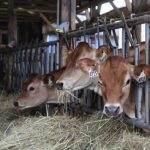
In 2012, there were 53 dairies in Carroll County, and now, approximately 24 remain, according to Bryan Butler, University of Maryland Extension agent, quoting numbers from the National Agricultural Statistics Service. Compare that to 731 dairy farms in Carroll County in 1959, 205 in 1978, and 92 in 2002.
“The dairy industry really drove our agricultural economy,” Butler said. “It was a huge cornerstone.”
But if Butler had to describe the last few years of the dairy industry in Carroll County?
“Devastating,” he said.
From Butler’s experience, dairy farmers don’t close up shop because they dislike their job. They shut down or downsize due to economics.
‘We’re barely breaking even’
“It takes a special kind of person that wants to do it. No one works at our farm that doesn’t like working with cows and the other people,” said Matt Hoff, owner of Coldsprings Farms in New Windsor.
Hoff is a fifth-generation dairy farmer. His family has been farming in the same spot since 1868. Coldsprings includes 2,200 acres, with some land in Taneytown, and 1,200 milking cows. He is president of Maryland & Virginia Milk Producers Cooperative Association, Inc., which includes farmers in Carroll County.
Hoff is one of the Carroll farmers who pushed for the Maryland Dairy Industry Association (MDIA) to find ways to bring more money back to local farmers. As a result, MDIA partnered with Carroll County Agricultural Center to secure a $40,000 grant from Maryland Agricultural Education and Rural Development Assistance Fund to conduct a dairy processing plant feasibility study, according to a news release.
Essentially, the study suggested there is a market for locally-produced dairy products such as queso fresco, and while the study was welcomed there is some skepticism.
Gary Dell, of Dell Brothers Inc., is the fourth generation of his family in the business, and his children the fifth. They farm about 2,400 acres between Gamber and Littlestown, Pennsylvania, and milk 90 cows. Dell Brothers started with 140 cows, according to Dell.
While dairy is Hoff’s primary business, the Dells see more profit elsewhere, such as in binding and selling grain. Dell estimates milk contributes to less than 20% of their overall revenue, compared to 30% in their prime.
“The dairy industry has been struggling,” Dell said.
The feasibility study suggests farmers try their hands at manufacturing dairy products, but Dell said most small, family-owned dairy farms don’t have the capital investment or the labor force to build and staff a manufacturing plant.
“Most dairy farmers already work 18 hours a day,” Dell said.
Dell’s wife Crystal is the only full-timer devoted to the cows.
“The small dairy farmer has kind of become obsolete,” she said. “We’re barely breaking even right now.”
Butler pointed to the “huge” amount of state regulations as a cause for headaches.
“It is very challenging for the farms that do want to do processing,” Butler said. “It becomes frustrating and overwhelming.”
And although there are fewer dairy farms, milk consumption doesn’t match what’s being produced.
“If there’s a demand, we will oversupply it,” Dell said.
Dell believes part of that has to do with the rise in milk alternatives that come from nuts.
Supply and demand
“Consumption is flat to down,” said Steve Connelly, assistant secretary for marketing, animal industries and consumer services for the Maryland Department of Agriculture.
The national supply of milk has increased over the last four years, while dairy consumption remains flat, according to Connelly.
“There’s a major consolidation of the dairy industry going on,” he said.
Production is on the downturn in Maryland, by approximately 1-2% per year over the last four years, Connelly said.
What’s more, farmers don’t set their own milk prices. That’s driven by the market, and it’s a complicated process.
“Farmers are price takers. They take the price the market gives them,” Connelly said.
The United States Department of Agriculture (USDA) explains the milk pricing process and history in a 24-page report. Some of the factors that influence milk prices include Federal Milk Marketing Orders (FMMO), import restrictions, export subsidies, domestic and international food aid programs, state-level milk marketing programs, and more, the report’s summary states.
FMMOs “establish certain provisions under which dairy processors purchase fresh milk from dairy farmers supplying a marketing area,” according to the USDA’s website. Marketing areas are where dairy processors “compete for packaged fluid milk sales,” the website states. “Federal orders serve to maintain stable marketing relationships for all handlers (dairy processors) and producers (dairy farmers) supplying marketing areas, thus facilitating the complex process of marketing fresh milk,” the website reads.
For farmers searching for government assistance, the Dairy Margin Coverage (DMC) Program may be a viable option.
The program, a product of the 2018 Farm Bill, replaced the Margin Protection Program for Dairy. It helps cover the expenses outside of feed costs, such as electricity or fuel, Connelly said.
In the 2019 legislative session, Gov. Larry Hogan devoted $1.5 million to cover one year’s worth of premiums for farmers that wanted to buy into the program at the highest level — $9.50 per hundredweight of milk, according to Connelly.
“We’re trying our best to find at least some form of a safety net that actually works for the dairy farmer,” Connelly said.
Signups for DMC ended Friday, according to Connelly.
Another contributing factor to the struggles of dairy farmers is that it is more costly to produce milk in the Northeast than in the plains of states such as Nebraska or Idaho, Connelly said. Land and labor costs are higher here, and farmers have to contend with environmental protections, like those in place to save the Chesapeake Bay, he said.
Despite the difficult nature of the business, the remaining Carroll County dairy farmers continue, passing on what they enjoy to the next generation.
“Dairy farmers like dairy farming because they like the way of life,” Hoff said. “No one does it because they think they’re going to be a billionaire from milking cows. They like doing what they do.”

























